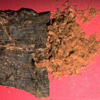Food

Varying customs of hunting, gathering, trapping, and preparing animals, birds, fish, and plants for food have developed among different Aboriginal Peoples, depending on the location of those Peoples’ traditional lands, and on what species were available to be captured. For peoples like the Dogrib and Inuit, species like caribou provided a main source of meat. Further south, among the Cree and Chipewyan, moose was a main meat provider. Other animals, like wood buffalo, deer, and bears, could also be hunted for food, while smaller animals and birds could also be eaten. Fish were also a large part of the northern diet, in part because fish species have predictable migration patterns and are therefore easier to catch. Types of fish that were favoured by many northern peoples are lake trout and walleye. Other fish, like northern pikes, were usually set aside for use by many northern peoples as food for dogs. Various fruit-bearing plants were also carefully observed, as different plants could bear fruit at different times of the year. Some fruits, like strawberries, were only available in the early to mid summer, while others, like high bush cranberries and rosehips could be picked throughout the year.
 Traditional food preparation had to take into account what type of bird,
fish, plant, or animal was to be consumed, and the amount of fresh food that
could be consumed before it spoiled. This was especially important in the summer
months, when warmer weather could rapidly spoil a catch. In the winter, meat or
fish could be frozen for later use. To reduce waste and make better use of the
animal or plant, methods of long term preservation of plant, meat, and fish
products had to be developed. For meat, fish, and berries, drying was a
preferred method of keep food for a longer term. Fish and meat drying conformed
to similar methods. Once skin, hide, scales, fur, or feathers had been removed,
the meat or fish was cut in such a manner so to allow most of the cut to dry.
The cut meat or fish was then placed on a drying rack over a fire using fresh
instead of dry wood for fuel. The smoke from this fire would help dry out the
meat. The meat or fish was either hung on willow racks out in the open, so that
sun and wind could aid in the drying of the flesh, or inside a teepee-like
smokehouse. Different types of wood, roots, or bark, like willow root, could be
added to the fire to create different smoke flavours in the meat. Berries were
dried or made into jams and jellies in order to preserve them. Berries could
also be combined with dry meat and animal fat to create pemmican, another food
source that could be stored for a long period of time without spoiling.
Traditional food preparation had to take into account what type of bird,
fish, plant, or animal was to be consumed, and the amount of fresh food that
could be consumed before it spoiled. This was especially important in the summer
months, when warmer weather could rapidly spoil a catch. In the winter, meat or
fish could be frozen for later use. To reduce waste and make better use of the
animal or plant, methods of long term preservation of plant, meat, and fish
products had to be developed. For meat, fish, and berries, drying was a
preferred method of keep food for a longer term. Fish and meat drying conformed
to similar methods. Once skin, hide, scales, fur, or feathers had been removed,
the meat or fish was cut in such a manner so to allow most of the cut to dry.
The cut meat or fish was then placed on a drying rack over a fire using fresh
instead of dry wood for fuel. The smoke from this fire would help dry out the
meat. The meat or fish was either hung on willow racks out in the open, so that
sun and wind could aid in the drying of the flesh, or inside a teepee-like
smokehouse. Different types of wood, roots, or bark, like willow root, could be
added to the fire to create different smoke flavours in the meat. Berries were
dried or made into jams and jellies in order to preserve them. Berries could
also be combined with dry meat and animal fat to create pemmican, another food
source that could be stored for a long period of time without spoiling.





